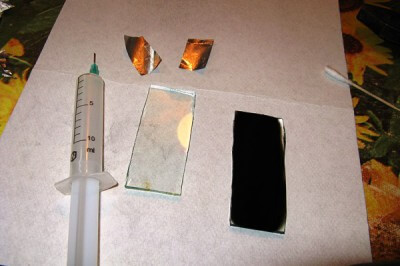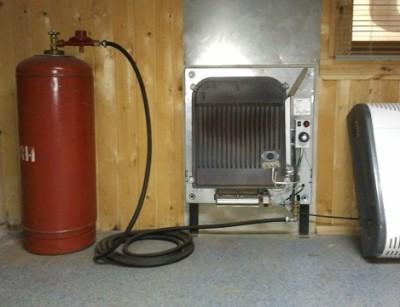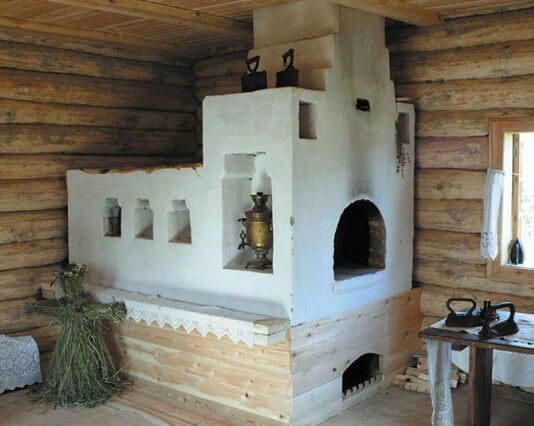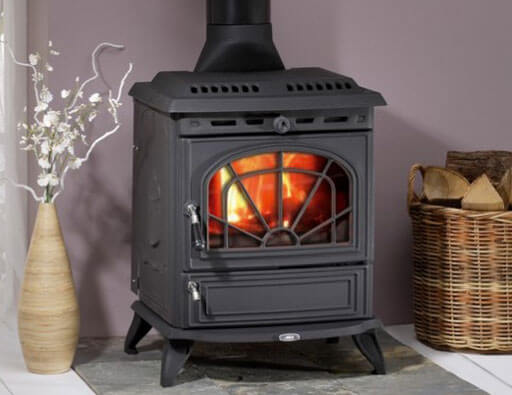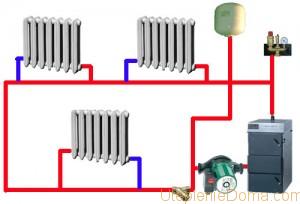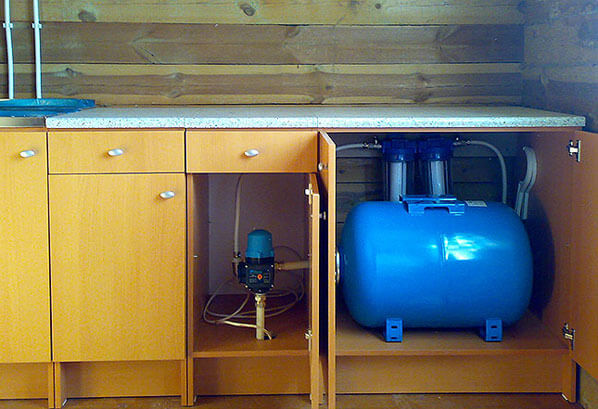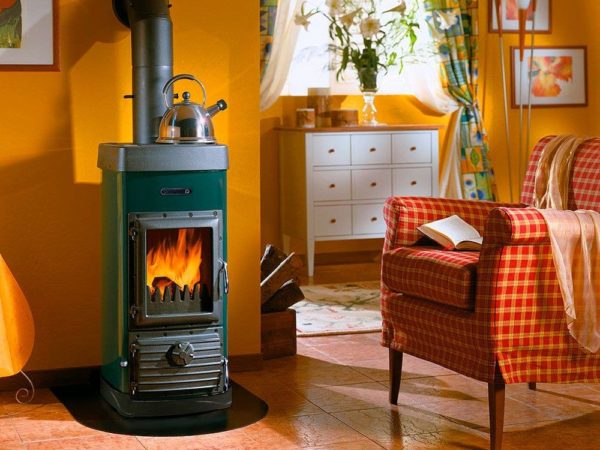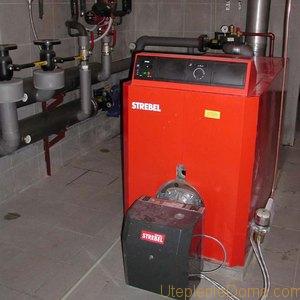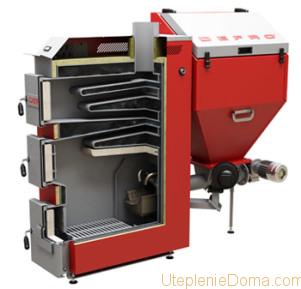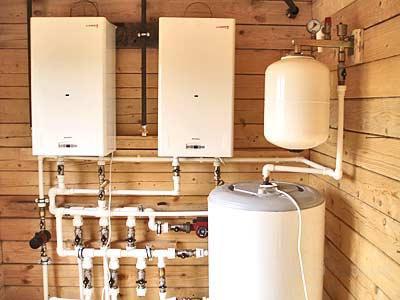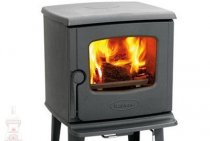Types of heaters
A home craftsman who wants to acquire a home-made "heater" can be offered several options to choose from:
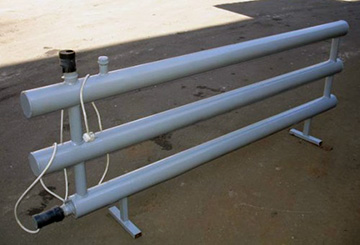
The main element of the heating element is a spiral made of nichrome or other material with high electrical resistance, which, when an electric current is passed through it, begins to heat up. The spiral is placed in a copper tube filled with sand.
The oil removes heat from the heating element, distributes it over the surface of the case and, in addition, serves as a heat accumulator (after a power outage, the device continues to heat the surrounding air for some time).
Vapor drop
In its design, a vapor-drop heater is very similar to an oil heater, only water vapor is used as a medium that distributes heat. It is formed from a small amount of water that is poured into the body.
This solution provides two significant advantages:
- When freezing, the vapor-drop heater will not burst, since water occupies only a small part of its volume.
- Steam is an extremely capacious heat accumulator. More precisely, not so much steam as the process of evaporation: it is during the transition from a liquid state to a gaseous state that water accumulates a large amount of thermal energy, which is returned when steam condenses on the walls of the heater.
Having given off heat to the body of the device, the condensed steam in the form of water flows into the lower part, where the heating element is installed. The power of the heating element and the volume of water are selected in such a way that the steam pressure does not break the heater.
Due to the fact that the body of the device is hermetically sealed, its walls from the inside from high humidity do not rust.
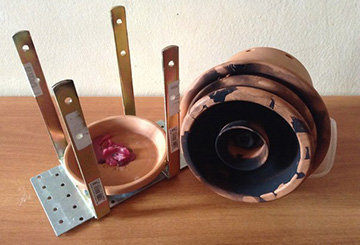
Only it usually disappears under the ceiling in the form of convective air currents and there it is “smeared” over the entire area of the room.
Why not install a heat trap above the candle? We will talk about what it is in the next section.
Infrared (IR)
Any substance with a temperature other than absolute zero emits "thermal" electromagnetic waves, which are called infrared.
The intensity of this radiation is directly dependent on the temperature of the substance. Water and oil radiators also propagate IR waves, but in very small amounts, since their surface is relatively cold.
To turn a metal object into an IR emitter, it is enough to heat it up to the red glow temperature. If, however, special materials are used, such as graphite, then sufficiently tangible "thermal" waves can be achieved even at relatively low temperatures.
Knowing these subtleties will help us make an IR heater with our own hands, which will give us heat directly, that is, without the participation of air as an intermediary.
Other types
Since electricity is not available everywhere, constructions that run on gas or solid fuels have the right to life. The latter include potbelly stoves.
Idea 1 Compact model for local heating
The easiest way to make an electric heater is this one. To get started, prepare the following materials:
- 2 identical rectangular glasses, each with an area of \u200b\u200babout 25 cm 2 (for example, 4 * 6 cm in size);
- a piece of aluminum foil, the width of which is not more than the width of the glasses;
- cable for connecting an electric heater (copper, two-wire, with a plug);
- paraffin candle;
- epoxy adhesive;
- sharp scissors;
- pliers;
- wooden block;
- sealant;
- several ear sticks;
- clean rag.
As you can see, the materials for assembling a homemade electric heater are not at all scarce, and most importantly, everything can be at hand. So, you can make a small electric heater with your own hands according to the following step-by-step instructions:
- Thoroughly wipe the glass with a cloth from dirt and dust.
- Using pliers, gently grab the glass by the edge and burn one of the sides with a candle. The soot should evenly cover the entire surface. Similarly, you need to burn one of the sides of the second glass. In order for carbon deposits to settle on the surface better, it is recommended to cool the glass before assembling the electric heater.
- After the glass blanks have cooled, carefully clean the edges with the help of ear sticks no more than 5 mm around the entire perimeter.
- Cut out two strips of foil, exactly the same width as the smoked area on the glass.
- Apply glue to the glass over the entire burnt surface (it is conductive).
- Lay the pieces of foil as shown in the photo below. Then apply glue to the other half and connect them.
- Then seal all connections.
- Using a tester, independently measure the resistance of a homemade heater. After that, calculate its power using the formula: P \u003d I 2 * R. How to use a multimeter. we have discussed in the corresponding article. If the power does not exceed the allowable values, proceed to the completion of the assembly. If the power is too high, you need to redo the heating element - make the layer of soot thicker (the resistance will become less).
- Glue the ends of the foil to one side.
- Make a stand out of a bar by installing contact pads connected to an electrical cord on it.
Here, using this technology, you can make an electric mini DIY heater. The maximum heating temperature will be about 40 o. which will be quite enough for local heating. However, such a home-made product will, of course, not be enough to heat a room, so below we will provide more efficient options for home-made electric heaters.
Heating in modern country houses
The principle of organizing a summer cottage heating system, thought out at the design stage of a house, is no different from heating systems for cottages and residential buildings. The decisive point is the presence of heating mains. And they usually don't. The second difference is the implementation of an economical intermittent heating option, rather than a daily one.
To do this, any system must provide: fast heating of the room, the required area, draining water from the pipeline during water heating and have a large capacity for efficient heating of houses with low thermal insulation properties.
The heating system in the country begins with the installation of the selected type of boiler and piping the house with pipes. Necessary work such as preparing a room for a boiler room, organizing devices necessary for ventilation of solid-state boilers, installing pipelines, starting up and testing is best entrusted to experienced professionals. The boiler can be electric, diesel, solid state and gas.
There are hybrid models of boilers that use solid fuel and electricity for operation. Their cost is much higher and they are not always profitable for summer cottages, where they do not live permanently in the winter. The easiest way to endure temperature changes in winter is a wood-fired boiler.
It also belongs to the category of economical options. The convection type of wood-burning boiler is the most common. It has a low noise level, which makes it possible to install it in the basement. A large selection of modern models of boilers allows you to increasingly use water heating.
When building a large cottage, it is the best heating option. Its essence lies in the possibility of constant circulation, heated to the desired temperature of water through pipes to batteries located in the house and back.For laying a pipeline, pipes made of metal, polypropylene or metal-plastic are most often used. They can be used for many decades only if properly preserved for the winter.
Another problem is the timely replacement of water filters, in the absence of which, the pipes quickly become clogged with various deposits of impurities contained in the water. As a coolant, not only water, but also saline, glycerin, propylene glycol can be used.
Each of them has its own advantages and disadvantages. Glycerin, for example, does not harden and retains its fluid properties even at a temperature of 30 ° below zero, which saves pipes from rupture. He is very expensive. Propylene glycol is not toxic, but its specific heat capacity is worse than harmful ethylene glycol. In connection with the growth in the construction of summer cottages from modern materials, it is most correct to involve experienced specialists in the implementation of your own heating system.
In order to keep warm in the country in winter, it is necessary to choose one of the heating options. In this case, a very important point is the advance warming of the house. Otherwise, the efficiency decreases sharply and the consumption of energy used increases. And it will be difficult to warm up.
Practical recommendations for organizing heating on video:
Pocket warmers for smartphones
A budget option for reusable heating devices for those who do not need long-term heat. Inside these small inserts there is a gel, which, after activation, is able to give off heat for about 20 minutes. True, after each use it will have to be kept in boiling water for 5 minutes - which is not very convenient. But these stylish inserts can not only warm your hands. Users share their life hacks: in severe frost, they put them in their pocket with their smartphone - and the battery does not die from low temperatures. Some of the models can also be used, if necessary, as "coolers" in the heat - having previously cooled in the refrigerator. The most popular models of gel heaters: For Pro Hand and Body Warmers, Hotsy!
and Hand Warmers - HotSnapZ Reusable Round & Pocket Warmers.
Furnace heating system
This type of heating is not very popular today, due to some of its features. However, many owners still prefer to carry out winter heating of the dacha using a traditional stove, so this method should be described in more detail, how to heat a country house is not so simple.
The main disadvantage of this option for heating a private house is the complexity of maintaining the furnace. So, for high-quality heating, the system should be ignited several times a day, laying new portions of fuel. If the material for ignition is coal, then in this case it is also necessary to regularly remove the emerging ash, which also requires a certain amount of time.
The main advantage of the furnace system is absolute autonomy. Heating a country house in winter by means of a stove does not require the use of either electricity or gas (in more detail: “How to heat a house if there is no gas“). The main fuel is only wood and coal. The elementary design of the device completely eliminates the risk of breakage. There are two main types of stoves:
- traditional Russian oven;
- heating system for cottages. called bourgeois.
The massive mechanism of the Russian stove can perform several useful functions at once. It is perfect for cooking, a warm surface allows you to sleep on such a stove, and, of course, such a unit is able to heat a private house
It is important to note that, due to its large size, heating can be provided to several residential premises at once, and the fact that the traditional Russian stove is made of brick ensures long-term heat retention and prevents any temperature fluctuations.
The disadvantages of such a furnace include its massiveness.For the equipment of such a heater, it will be necessary to allocate from 6 to 8 m² in the room. In addition, the time for heating such a furnace is long (bricks need at least several hours to warm up). It is impossible not to mention the fact that it is worthwhile to mount a Russian stove only in one-story buildings, because otherwise the design will already look little like a stove and will look like real industrial equipment, which is huge.
Heating a summer house in winter with a potbelly stove is different from a stove. This equipment takes up very little space (about 1 m²). The warm-up time is very fast and little fuel is required. In addition, if desired, you can cook food on the surface of the potbelly stove or, for example, boil a kettle.
However, these products also have disadvantages. The potbelly stove cools down as quickly as it warms up, therefore, in order to avoid frequent temperature changes in the room, fuel will have to be loaded very often, which is especially inconvenient at night. Moreover, only one room can be provided with heat for a potbelly stove, since such equipment does not have enough power to heat more rooms, so it is better to refuse to use a potbelly stove in a large house.
Water heating system on electricity
A water system is an efficient heating option.
This option is more preferable than the use of liquid fuel boilers. First of all, because of the power of the equipment and the possibility of heating all rooms. Before you start equipping your home with such a system, you need to make accurate calculations.
First you need to select the boiler and determine the location of the batteries. To do this, it is necessary to take into account the area of \u200b\u200bheated rooms, the insulation material on the walls (if any) and the heat loss of the house in the winter season. It will be good if the building is connected to the water supply system, but practice shows that this is often not possible. After that, you need to draw up a plan for the movement of water through the pipes.
The advantages of this method include:
- autonomy of work;
- safety and environmental friendliness;
- no need for costly maintenance and repairs.
Water heating system of the cottage
Another option for heating a summer house in winter is to use heating boilers. Despite some complexity of their installation, the result will be unambiguously positive.
Based on what fuel is used, boilers are usually divided into the following types:
- diesel systems;
- gas boilers;
- solid fuel boilers.
One of the most common boiler systems are diesel-fueled devices. Nevertheless, such equipment can hardly be called innovative, since today the price of diesel fuel is very high, so not everyone can afford to install such a unit.
However, these products do not have other serious drawbacks, with the exception of the emission of unpleasant smoke during operation. To get rid of burning, the chimney of such a boiler should be mounted on the surface.
Among the advantages of these mechanisms are the possibility of storage in a large tank, high energy intensity, as well as autonomy of work, which makes it possible to exclude the participation of the owners in the process of functioning of the device.
Gas boiler systems are becoming more and more common. All that is required for their installation is the presence of a stable working gas supply point. Gas has more advantages over diesel fuel. This natural fuel costs much less, in addition, no harmful substances and acrid smoke appear during its combustion, and it is not necessary to store such fuel in large volumes.
The main disadvantage of these boilers is the risk of fire. Even a small gas leak can cause very serious and unpleasant consequences.It is this shortcoming that scares away many consumers, although in fact the danger of an explosion in modern devices is practically reduced to zero.
To completely eliminate the risk of fire, experts recommend installing this room not under the house, but in a separate room. In addition, before starting installation, the right decision would be to study various photos of gas structures and detailed videos on their installation.
An example of self-implementation of summer cottage heating in winter:
Another type of boilers is solid fuel. They are used less often than the systems described above, in particular, due to potential problems during their operation. Bookmarking fuel should be done manually, which is not always convenient.
Among the advantages of solid fuel boilers is the low cost of consumables, such as wood, peat, coal, and the fuel itself can be stored anywhere
It is only important to provide him with protection from getting wet.
Types of heating systems for country houses
Types of heating systems may depend on the available energy resource, design features, climatic conditions, and the budget of the dacha owner.
The main types of space heating are:
- gas heaters;
- electric heaters;
- furnace equipment;
- equipment operating on a liquid fuel resource;
- equipment operating on a solid fuel resource;
- universal heating systems.
The choice of each type of heating requires drawing up a budget of expenses, taking into account the area of \u200b\u200bthe building that needs heating. The choice of the method of heat supply will depend on the support of the positive temperature at the time of absence at the summer cottage.
Heating of the cottage without gas water heating system on diesel
Diesel boilers can be a replacement for gas heating.
Diesel boilers are quite popular. running on solar or diesel fuel. On sale you can find equipment for kerosene, rapeseed oil and other liquids. The advantages of using such boilers include:
- high level of efficiency (at least 92%);
- no need to obtain permits and approvals for the installation of such a boiler.
Before buying, be sure to find out about the cons:
- high level of fire hazard;
- such a boiler is not considered environmentally friendly;
- fuel for the boiler is difficult to store - for example, for diesel fuel, you need to allocate a separate room, preferably not adjacent to a residential building;
- the cost of fuel is not cheap.
Heater camping stove for heating food from cans spirit lamp
The design is known abroad under the name alcohol stove, well, or in Russian - a spirit stove. In the Swedish army even adopted.
Alcohol is used because it does not smoke when burned. So the dishes remain clean and soot and smoke do not fly in the air. The design is simple, like 3 kopecks and is repeated in a few minutes from any materials at hand. As a donor for the stove, for example, a beer can, a can of coffee or condensed milk is suitable.
More specifically: you need a small iron container with an iron lid, or you will have to cover it with something.
The author used a can of Korenovsky condensed milk - it is convenient because there is an almost airtight lid on top, but everything will work without it if there is a dish with a flat bottom on top.
So: we take a jar, a ruler, a strip of a leaf in a box and a marker or any drawing or scratching object.
1. We mark a strip on the bank stepping back from the top by a third. The easiest way to do this is by scrolling the jar while holding the marker in one position.
2. We wrap a strip of paper around the edge of the mark and fasten it with a piece of adhesive tape or glue.
3. We begin to drill, pierce with an awl or cut holes with a knife along the marked strip. In this case, I made a series of holes with a diameter of 0.8 mm through 10 mm and through 5 mm - which option is better for you - decide for yourself. You can see how they burn below.A small hole diameter for proper combustion is better than a large one, but you can make 3-5 holes and a centimeter. The uniformity of the holes is a purely aesthetic moment to get a beautiful crown of flame like from a conventional gas stove. Everything!
Well, not quite of course, now we are learning to kindle it. It is necessary to pour alcohol and close the lid, 50 ml burns for 15 minutes or more. Place on a non-combustible surface and shake lightly so that the alcohol pours a little through the holes on the outside of the jar. We set fire to the alcohol outside and wait until it burns out. We repeat the procedure until we get a self-sustaining flame from improvised nozzles around the jar. Usually it is enough to repeat 2-3 times and everything starts working by itself.
Its principle of operation is simple: the flame heats the walls of the jar, the heat is transferred down the walls to the alcohol, the alcohol boils near the walls and the pressure inside rises, the alcohol vapors come out under pressure through the holes and, mixing with air, burn beautifully. Now we put a pot, kettle, mug on top or just warm ourselves around the stove - it gives a lot of heat and burns for a long time.
For greater heat transfer, you can put a home-made spirit lamp in a large iron container, which would heat up and give off heat:
The smaller the number of holes, the harder it is to kindle, but less fuel consumption and less heat from it. A liter of water boils in less than 10 minutes. Resistant to wind, put out by covering, lay as much fuel as necessary, otherwise you will have to wait for burnout or pour hot alcohol back into the container, which is not safe.
Similar “one-cup” options from a can with a filling hole that closes with a coin and from an aerosol can:
Pellets economical heating of the house without gas and pipes
Pellet boilers are a modern alternative to gas.
Pellets are considered an alternative source of energy. They are made from wood waste (shavings, sawdust) or from agricultural waste.
It is worth noting that many Europeans, trying to find options on how to heat a country house without gas, choose pellet boilers. evaluating the economics of their use.
The benefits of using pellets include:
- environmental safety (one granule contains a maximum of 3% ash);
- maximum safety of use, since this fuel is not subject to self-ignition;
- pellet boilers have a high level of efficiency;
- low cost of "fuel", which ensures energy-saving heating without gas.
Now you know how to heat a cottage without gas. As you can see, there are many different options, and therefore, to choose, you need to focus on your financial capabilities and needs.
Interesting on the topic:
- Heat meters: how to install
- Features of installation of circulation pumps dl.
- What is AOGV, types and installation
- Boilers Bear: an overview of the model range and character.
How to heat the cottage in winter practical recommendations
At this time of the year, there is no tedious weeding, planting, watering and other time-consuming, but very interesting for people of any age. There is time to just walk among the snow-covered garden, dream and plan the beds for future plantings. Clear the paths from snow, and then warm up and drink fragrant tea infused with herbs in your home. The main thing is that it should be warm, which can be created, but not always easy.
Modern technologies mastered in the production of building materials allow you to choose any of them and build even a multi-storey cottage in a short time. And immediately with a well-thought-out heating system, designed and implemented not only independently, but also with the involvement of specialists in this field.
Method 1 electric convectors
With the help of electric convectors, it is realistic to provide a cheap and efficient heating system.The electric convector is built on the principle of natural air circulation. From the heater, warm air moves upwards, thus stimulating the movement of air inside the room, and ensuring uniform heating. However, the convector is effective only in a warm climate, when the temperature does not fall below 10-15 degrees.
pros
- No forced air blowing. Even in the cleanest home, there are solid particles that lie on surfaces. By artificially blowing warm air out of a heater, this dust becomes part of the air we breathe. Natural air circulation is not so active, therefore, dust does not rise into the air.
- Small size with sufficient power. The heating elements of convectors heat up quickly, converting electricity into heat with an efficiency of up to 80%. In addition, there is a system of operation in different modes, as well as thermostats that allow you to work not constantly, but only when the air temperature drops.
- Mobility that allows you to move the convector around the room, to places with maximum cold supply.
- The possibility of creating a heating system exclusively with the help of convectors or using them as an integral part of a more complex heating system.
- The electric heating element does not heat up more than 100 degrees, and the body - 60 degrees. They have an increased level of protection against moisture, which allows the use of the convector in the kitchen and bathrooms.
Minuses
- The disadvantages of electric convectors is the installation of heaters in every room of the house.
- In addition, if you turn them on at the same time, then there is a possibility of exceeding the limits of permissible power.
In the photo there is an electric convector from Nobo, Norway
